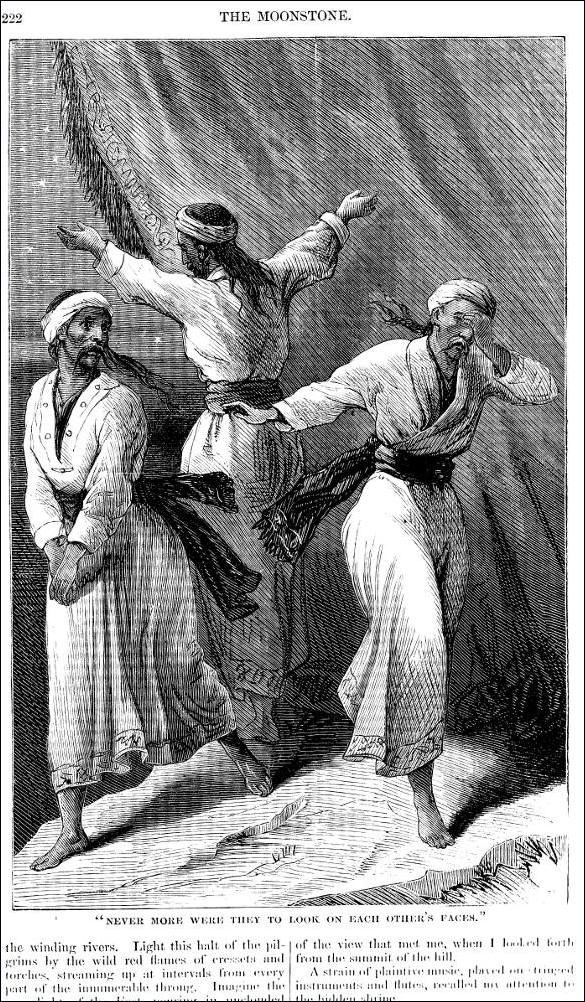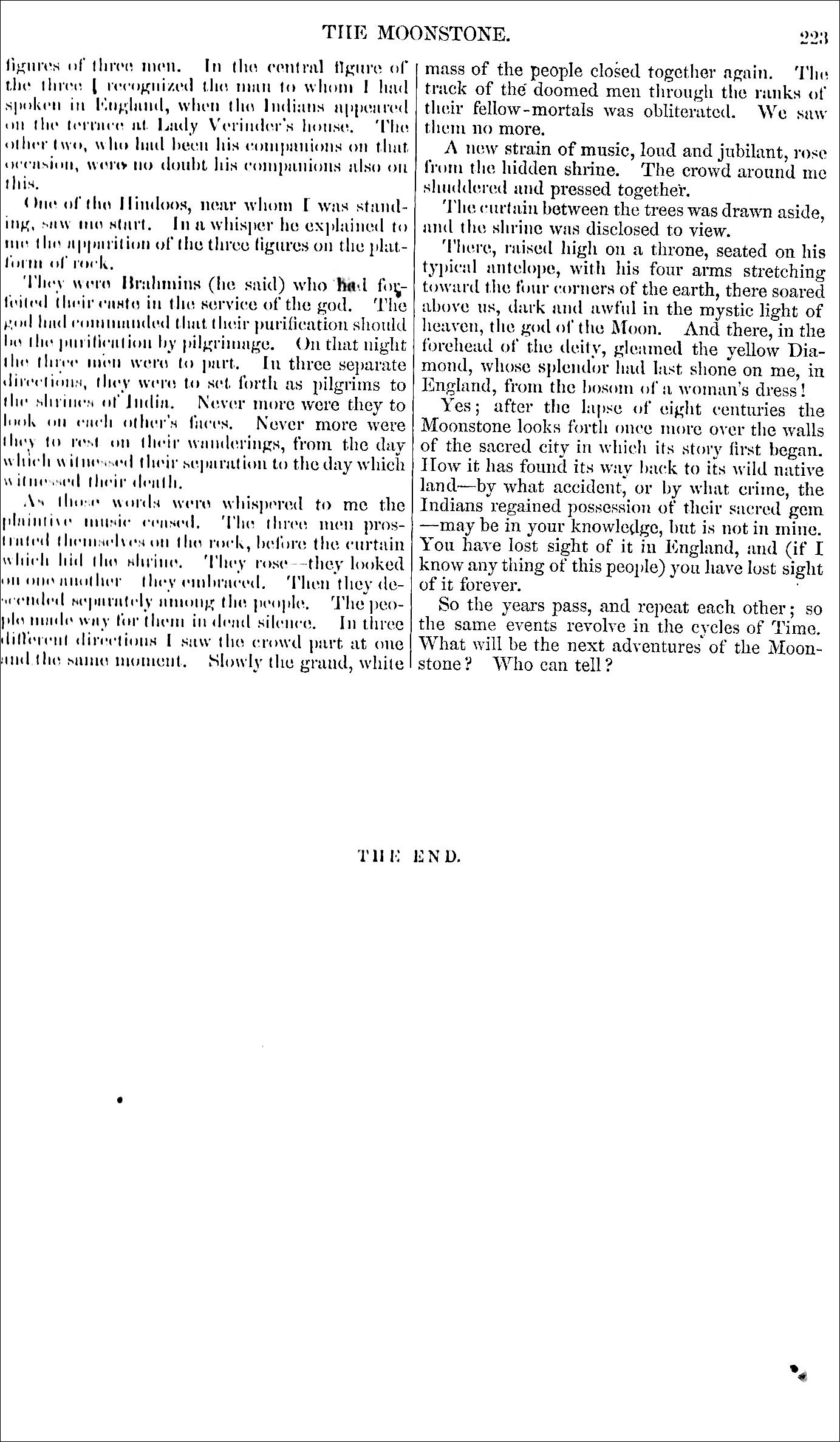

The closing pages of the July 1868 first edition of Wilkie Collins's A Moonstone. A Novel demonstrate how the large-scale illustrations such as "Never more were they to look on each other's faces" (in serial, 8 August 1868) informed the volume reader's assessment and enjoyment of the end of the novel. Throughout the closing paragraphs of the novel in volume the American reader (unlike his English counterpart at the conclusion of the third volume in the Tinsley publication) would have mediated the text with the illustration, aware of the almost operatic wave of sorrow that engulfs the Brahmins at having to sacrifice their life-long friendship as an expression of their devotion to the Hindu God of the Moon.
Scanned images and text by Philip V. Allingham. The illustrations appearing here are courtesy of the E. J. Pratt Fine Arts Library, University of Toronto, and the Irving K. Barber Learning Centre, University of British Columbia. [You may use the images without prior permission for any scholarly or educational purpose as long as you (1) credit the person who scanned them and (2) link your document to this URL or cite the Victorian Web in a print one.]
The Final Illustration in the 1868 Volume
In this final illustration, the artist and novelist both depict the Brahmins as brothers, and hardly blood-thirsty foreigners bent on shedding the blood of the infidel. Rather, the trio enact a ballet of despair, for these priests of the Hindu Moon God have been commanded by their deity to purify themselves of the taint of their experiences in the West by separating forever. No longer depicted as savage killers or thugs, here they acknowledge in their pious gestures and solemn expressions the tragic necessity of living apart after so many years together in the devoted service to the god. The individual in foreground with the long moustache is the leader, the same man who, in European garb, visited Mr. Bruff to ascertain the length of the loan on the Moonstone. The illustration is effective, then, in eliciting the American reader's sympathy for the East Indian priests who, in disguising themselves as jugglers, have lost caste, and have blood on their hands, albeit hardly "innocent" blood.
Whereas in The Perils of Certain English Prisoners in the Extra-Christmas number of Household Words for 1857 Dickens and Collins had expressed opposing sympathies for those who have been colonized by a European power, there is no dissonance in the closing and coherent voice of the celebrated Indian traveller, Mr. Murthwaite, whose sympathetic diction — "forfeited their caste," "purification byn pilgrimage," "Never more," and "plaintive music" (223) — complements the overwhelming sadness of the figure two rear, arms extended (presumably to the assembled body of worshippers below the "rocky platform") and of the the figure to the left, who regards with deep concern the posture and visage of his leader (right), who brushes aside his friend's concern with his right hand as he tries to hide tears of anguish with his left. Just as Collins is unreservedly in sympathy with the Brahmins (whose dedicated service to their deity has led to murder, after all), so the American artist depicts the trio in individualised postures of despair in order to enlist the reader's appreciation of all that they have sacrificed and will continue to sacrifice. The fringed and embroidered curtain to the rear is being drawn aside to reveal the stars as images of destiny in the night sky, and the posture of the Brahmin to the rear repeats the gesture of the Hindu God of the Moon, "with his four arms stretching toward the four corners of the earth" (223) in the letterpress. The moving account of Mr. Murthwaite culminates in a description of the diamond restored to the forehead of the idol and shining with yellowish intensity upon the narrator; the artist focuses instead upon the varied reactions of the three who have restored the Moonstone to the likeness of their deity.
Images of Brahmins and Their Destination by Sharp, 1946


Left: William Sharp's recreation of the (imagined) scene in which the Brahmins take ship for India, The Three Brahmins Depart (uncaptioned: 1946). Right: William Sharp's depiction of the temple at Somnath, Uncaptioned Tail-piece (1946). [Click on the images to enlarge them.]
Commentary: The 1868 [July] Harper and Brothers' Volume "With many illustrations"
The Moonstone first appeared serially in All the Year Round (London) and Harper's Weekly (New York), simultaneously, in thirty-two weekly instalments (4 January through 8 August, 1868). Befre the magazines had even issued the closing numbers it appeared in volume as The Moonstone: A Romance in three volumes (London: Tinsley, 1868). The first American single-volume edition entitled The Moonstone. A Novel was published only a few days after the British edition in July in octavo with the original serial illustrations; however, the British triple-decker was unillustrated. A second edition published by Harper and Brothers in 1874 lacks the refinement and forty-nine of the original magazine illustrations. That the story has been filmed in 1909, 1915, 1934, 1972, and 1997 attests to its enduring appeal, although its popularity may now be restricted to courses in crime and detection fiction and the Victorian.
Related Material
- The Moonstone and British India (1857, 1868, and 1876)
- Detection and Disruption inside and outside the 'quiet English home' in The Moonstone
- Illustrations by F. A. Fraser for Wilkie Collins's The Moonstone: A Romance (1890)
- Illustrations by John Sloan for Wilkie Collins's The Moonstone: A Romance (1908)
- Illustrations by Alfred Pearse for The Moonstone: A Romance (1910)
- The 1944 illustrations by William Sharp for The Moonstone (1946)
Bibliography
Collins, Wilkie. The Moonstone: A Romance. With sixty-six illustrations. Harper's Weekly: A Journal of Civilization. Vol. 12 (1868), 4 January through 8 August, pp. 5-503.
________. The Moonstone: A Romance. All the Year Round. 1 January-8 August 1868.
_________. The Moonstone: A Novel. With many illustrations. First edition. New York & London: Harper and Brothers, [July] 1868.
_________. The Moonstone: A Novel. With 19 illustrations. Second edition. New York & London: Harper and Brothers, 1874.
_________. The Moonstone: A Romance. Illustrated by George Du Maurier and F. A. Fraser. London: Chatto and Windus, 1890.
_________. The Moonstone, Parts One and Two. The Works of Wilkie Collins, vols. 5 and 6. New York: Peter Fenelon Collier, 1900.
_________. The Moonstone: A Romance. With four illustrations by John Sloan. New York: Charles Scribner's Sons, 1908.
_________. The Moonstone: A Romance. Illustrated by A. S. Pearse. London & Glasgow: Collins, 1910, rpt. 1930.
_________. The Moonstone. Illustrated by William Sharp. New York: Doubleday, 1946.
_________. The Moonstone: A Romance. With nine illustrations by Edwin La Dell. London: Folio Society, 1951.
Farmer, Steve. "Introduction" to Wilkie Collins's The Moonstone. Peterborough, ON: Broadview, 1999. Pp. 8-34.
Leighton, Mary Elizabeth, and Lisa Surridge. "The Transatlantic Moonstone: A Study of the Illustrated Serial in Harper's Weekly." Victorian Periodicals Review Volume 42, Number 3 (Fall 2009): pp. 207-243.
Lonoff, Sue. Chapter 7: "The Moonstone and Its Audience." Wilkie Collins and His Readers: A Study in the Rhetoric of Authorship. New York: AMS Studies in the Nineteenth Century, 1982. Pp. 170-227.
Marshall, William H. Ch. 5, "The Major Novels, 1868-70." Wilkie Collins. New York: Twayne, 1970.
Nayder, Lillian. Unequal Partners: Charles Dickens, Wilkie Collins, & Victorian Authorship. London and Ithaca, NY: Cornll U. P., 2001.
Vann, J. Don. "The Moonstone in All the Year Round, 4 January-8 1868." Victorian Novels in Serial. New York: Modern Language Association, 1985. Pp. 48-50.
Created 27 September 2016
Last updated 13 November 2025